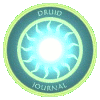Tell me, men of learning, what is Longing made from?
What cloth was put in it that it does not wear out with me?
Gold wears out, silver wears out, velvet wears out, silk wears out,
Every ample garment wears out — yet Longing does not wear out.
Great Longing, cruel Longing, is breaking my heart every day;
When I sleep most sound at night, Longing comes and wakes me.
–Excerpt from an old Welsh poem
 I picked up this verse from The Mist Filled Path. The Longing described by the poet can be a powerful force for personal growth. Cultivated properly, trimmed and clipped at intervals, Longing and other semi-painful emotions can add a lot of character and vitality to the garden of your soul. But they can take over and strangle the other flowers if you don’t keep them in check. In this post and a couple later ones I want to present my favorite meditation for finding respite and peace.
I picked up this verse from The Mist Filled Path. The Longing described by the poet can be a powerful force for personal growth. Cultivated properly, trimmed and clipped at intervals, Longing and other semi-painful emotions can add a lot of character and vitality to the garden of your soul. But they can take over and strangle the other flowers if you don’t keep them in check. In this post and a couple later ones I want to present my favorite meditation for finding respite and peace.
The meditation is rather different from others that I have read about, which frequently take the form of elaborate visualizations. There is certainly nothing wrong with that — I use visualizations all the time, and I find it very effective. But this meditation, which has three parts, works directly with your feelings, with no intermediating symbolism. As such, I find it very powerful, immediate medicine.
A word of warning before we proceed. Whenever you do this, make sure you do all three parts of the meditation in sequence. If you stop part way through, at best, the meditation won’t work, and at worst, you might mess yourself up. You definitely will mess yourself up if you do just one part of the meditation consistently and repeatedly without doing the others. I think that will be obvious as I describe it to you.
Here’s a quick overview:
1. Cut away bad feelings. This step, drawn directly from Buddhism, strips away all your negative emotions and attachments, leaving nothing but pure, rational thought.
2. Put it in good feelings. This step also comes from Buddhism, but Christianity is good for this too. (By “Christianity” I mean Christianity as it was intended to be.) Here, you fill yourself with selfless compassion.
3. Lock it in. This step comes directly from Taoism, and brings you, selfless, unattached, filled with compassion, directly into the Now — the bright glittering paradox of the present moment.
If that sounds good, read on.
Step one: the merciless knife.
I have been in many shapes:
I have been a narrow blade of a sword.
I have been a drop in the air.
I have been a shining star.
I have been a word in a book.
I have been an eagle.
I have been a boat on the sea.
I have been a string on a harp.
I have been enchanted for a full year,
In the foam of the water.
There is nothing in which I have not been.
–Taliesin
Step one has a dangerous-sounding name for a reason: it can be dangerous if you do it too frequently without doing the other parts of the meditation. It removes your attachments, so if you are attached to something (for example, your wife and children) — that is, if your affection for them is based on anything other than pure compassion — those feelings will be temporarily removed. This is why the second part of the meditation, the loving-kindness meditation, is so important.
The first step is to figure out what’s bothering you — figure out what it is that’s keeping you from feeling at peace. (If you’re already feeling peaceful, there’s no particular reason to do the meditation.) Sometimes it’s hard to figure out what is bothering you, and if that’s your situation, I suggest using a different meditation to figure that out. I tend to use the wondering/wandering-in-the-the woods meditation I’ve described before, but others will work, obviously.
Once you find out what’s bothering you, figure out where you’re attached to it. It’s a simple fact that, if something is bothering you, you’re attached to it in some way — emotionally attached to it. You can figure out where you’re attached to something with a very simple technique. Repeatedly ask yourself why something is bothering you until you reach an answer that includes the phrase because I want. That thing you want is the attachment.
For example, suppose your kids are always driving you crazy. Ask yourself: why? Why do they drive you crazy? Maybe there are any number of reasons; take them one at a time. Because they don’t clean up their messes. Because they always ask for things at the store. Because, instead of putting on their pajamas when you ask them to, they run around upstairs, naked, giggling, and screaming, “I can see your booty!”. (Can you tell that some of these examples were drawn from personal experience?)
Ask yourself: why do I want them to clean up their messes? If the answer is “because I hate seeing toys everywhere”, that you’re done, you’ve identified your attachment, and you can go onto the next step. If the answer is “because they need to learn to treat their things nicely”, that you ask: why do you want them to learn to treat their things nicely? Maybe the answer is “so they’ll grow up to be responsible adults.” Then you ask yourself: why do you want them to be responsible adults? Maybe the answer is: “I don’t want to fail as a parent”. You found your attachment — go onto the next step.
With each question you ask, you should feel yourself getting closer to the source of your fear. If you find yourself wandering off into philosophical ruminations about the role of tidiness in adult society, you’ve lost the scent. Remember you’re looking for fear — you’ll be able to feel it getting closer. If you lose the scent, go back and start again. Maybe it isn’t the untidiness of the toys that bothers you at all, maybe it’s just the fact that the kids didn’t do what you asked them to. Keep asking different questions until you track down that fear.
With practice, you’ll be able locate the fear almost instinctively. And sometimes, of course, it’ll be a lot easier than others. If you don’t like to fly on an airplane because you’re convinced that the only thing keeping the plane in the air is your white-knuckled grip on the seat’s armrests, then it’s not hard to figure out where the fear is.
Once you’ve located your fear, you’ve got to let it go. Let go of the thing you’re attached to.
There are number of different ways to do this.
The most direct way is simply to accept — emotionally accept — the possibility of losing what your attached to. Ask yourself, what’s the worst thing that could happen? And then accept that possibility. Let it be okay.
This can be extremely difficult, I won’t lie to you. There are a number of techniques that I use. Here are some tips:
1. Remember that almost all situations are temporary. In the great story of your life, how important is this really?
2. Remember that you are only an imperfect animal. Your sub-species only evolved about 35,000 years ago; you cannot be expected to do everything perfectly.
3. If you’re worried about your status, your income, or anything like that, remember that these are impermanent things that do not reflect on your true self worth, and they’ll be gone when you’re dead anyway.
4. If you’re afraid of making mistakes that can hurt other people’s lives (like being a bad parent), remember that there probably plenty of people doing a worse job than you are, and that the universe works in mysterious ways — things that seem bad or hurtful in the short-term frequently (dare I say always?) turn out for the best in the end. Besides, if your heart is pure and open, you can never really hurt anyone. (You might hurt their bodies accidentally — for that, see the next tip.) (And if your heart is not pure and open — well, that’s why we’re doing this meditation.)
5. Remember that the self is an illusion anyway; so anything you think you are responsible for, any attributes you think you may have such as intelligence, memory, and so forth — your ownership of them is an illusion as well. This “self” that is “you” is always changing, always moving.
You are like a river. What is a river?
- Is it the water of the river? But the water was always rushing past; a single drop of water may travel from the source to the mouth of a river in a few years at most, and then it is lost in the ocean. But the river is still there. So it’s not the water.
- Is it the river bed? But a river bed with no water is no river. Besides, a river bed is composed of a multitude of individual bits of earth, rock, and sand, always being scraped away by the water and carried downstream.
- The river cannot even be defined as a shape that holds constant over time. Rivers can change course with variations in climate, rainfall, and human activity.
What is a river then? It is an illusion caused by the short span of a human lifetime.
The same is true of the self. Everything I just listed about rivers is also true of our bodies and egos.
Once you release a fear, even temporarily, you can actually feel a weight being physically lifted off of your shoulders. You start breathing more deeply, muscles all over your body relax, your head feels lighter and you can sit straighter, and there is a deep feeling of relief. Your mind feels wide open, like a deep, clear sky. It is a taste of enlightenment.
You are ready go on to the next step: loving kindness.





Leave a reply to Jeff Lilly Cancel reply